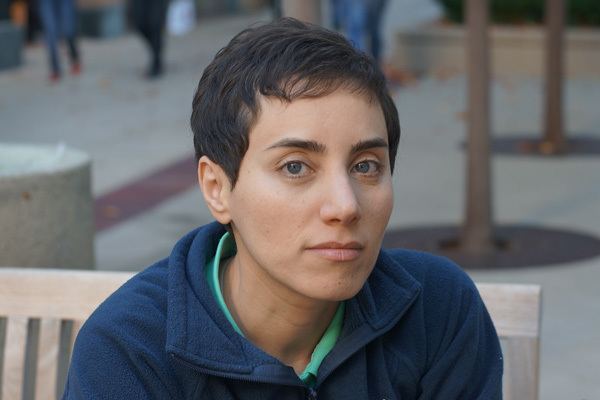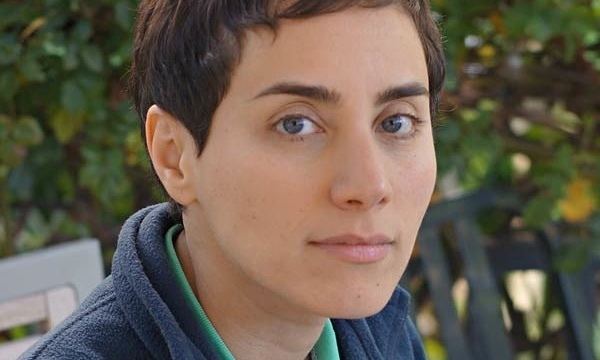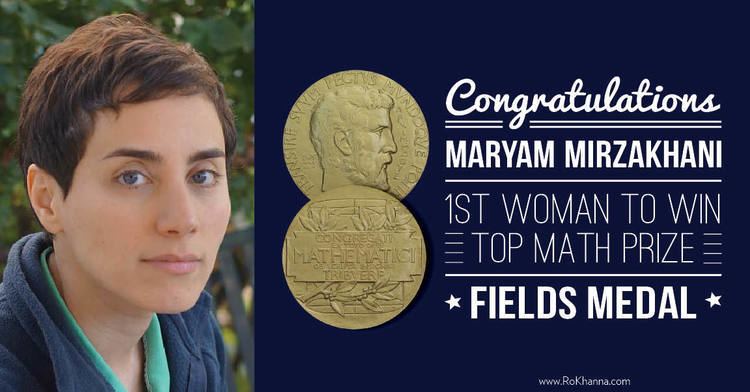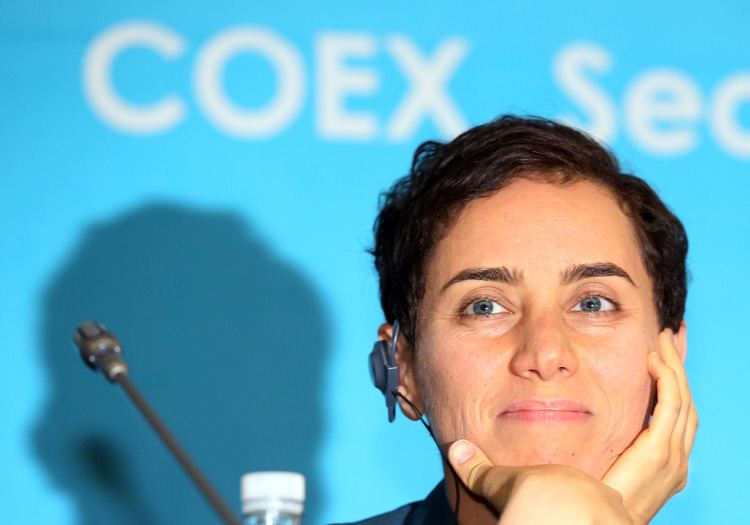Spouse Jan Vondrak Parents Ahmad Mirzakhani | Name Maryam Mirzakhani Fields Mathematician Role Mathematician | |
 | ||
Institutions Princeton UniversityStanford University Similar People | ||
Maryam mirzakhani an iranian born professor is first woman to win fields medal
Maryam Mirzakhani (Persian: مریم میرزاخانی, [mæɾˈjæm miːɾzɑːxɑːˈniː]; 3 May 1977 – 14 July 2017) was an Iranian mathematician and a professor of mathematics at Stanford University. Her research topics included Teichmüller theory, hyperbolic geometry, ergodic theory, and symplectic geometry.
Contents
- Maryam mirzakhani an iranian born professor is first woman to win fields medal
- Maryam Mirzakhani Dynamics Moduli Spaces of Curves I
- Early life and education
- Career
- Research work
- Personal life
- Death and legacy
- Awards and honors
- References

On 13 August 2014, Mirzakhani was honored with the Fields Medal, the most prestigious award in mathematics. Thus, she became both the first woman and the first Iranian to be honored with the award. The award committee cited her work in "the dynamics and geometry of Riemann surfaces and their moduli spaces".

On 14 July 2017, Mirzakhani died of breast cancer at the age of 40.

Maryam Mirzakhani, Dynamics Moduli Spaces of Curves I
Early life and education

Mirzakhani was born on 3 May 1977 in Tehran, Iran. Her father Ahmad is an electrical engineer. She attended Tehran Farzanegan School there, part of the National Organization for Development of Exceptional Talents (NODET). In 1994, Mirzakhani achieved the gold medal level in the International Mathematical Olympiad, the first female Iranian student to do so. In the 1995 International Mathematical Olympiad, she became the first Iranian student to achieve a perfect score and to win two gold medals.

She obtained her BSc in mathematics in 1999 from the Sharif University of Technology. She then went to the United States for graduate work, earning her Ph.D. in 2004 from Harvard University, where she worked under the supervision of the Fields Medalist Curtis T. McMullen. At Harvard she is said to have been "distinguished by ... determination and relentless questioning", despite not being a native English-speaker. She used to take her class notes in Persian.
Career

Mirzakhani was a 2004 research fellow of the Clay Mathematics Institute and a professor at Princeton University. In 2008, she became a professor at Stanford University.
Research work
Mirzakhani made several contributions to the theory of moduli spaces of Riemann surfaces. In her early work, Mirzakhani discovered a formula expressing the volume of the moduli space of surfaces of type (g,n) with given boundary lengths as a polynomial in those lengths. This led her to obtain a new proof for the formula discovered by Edward Witten and Maxim Kontsevich on the intersection numbers of tautological classes on moduli space, as well as an asymptotic formula for the growth of the number of simple closed geodesics on a compact hyperbolic surface, generalizing the theorem of the three geodesics for spherical surfaces. Her subsequent work focused on Teichmüller dynamics of moduli space. In particular, she was able to prove the long-standing conjecture that William Thurston's earthquake flow on Teichmüller space is ergodic.
Most recently as of 2014, with Alex Eskin and with input from Amir Mohammadi, Mirzakhani proved that complex geodesics and their closures in moduli space are surprisingly regular, rather than irregular or fractal. The closures of complex geodesics are algebraic objects defined in terms of polynomials and therefore they have certain rigidity properties, which is analogous to a celebrated result that Marina Ratner arrived at during the 1990s. The International Mathematical Union said in its press release that "It is astounding to find that the rigidity in homogeneous spaces has an echo in the inhomogeneous world of moduli space."
Mirzakhani was awarded the Fields Medal in 2014 for "her outstanding contributions to the dynamics and geometry of Riemann surfaces and their moduli spaces". The award was made in Seoul at the International Congress of Mathematicians on 13 August. At the time of the award, Jordan Ellenberg explained her research to a popular audience:
[Her] work expertly blends dynamics with geometry. Among other things, she studies billiards. But now, in a move very characteristic of modern mathematics, it gets kind of meta: She considers not just one billiard table, but the universe of all possible billiard tables. And the kind of dynamics she studies doesn't directly concern the motion of the billiards on the table, but instead a transformation of the billiard table itself, which is changing its shape in a rule-governed way; if you like, the table itself moves like a strange planet around the universe of all possible tables ... This isn't the kind of thing you do to win at pool, but it's the kind of thing you do to win a Fields Medal. And it's what you need to do in order to expose the dynamics at the heart of geometry; for there's no question that they're there.
In 2014, President Hassan Rouhani of Iran congratulated her for winning the topmost world mathematics prize.
Mirzakhani has an Erdős number of 3.
Personal life
In 2005, Mirzakhani married Jan Vondrák, a Czech theoretical computer scientist and applied mathematician who currently is an associate professor at Stanford University. They have a daughter named Anahita. Mirzakhani lived in Palo Alto, California.
Mirzakhani described herself as a "slow" mathematician, saying that "you have to spend some energy and effort to see the beauty of math." To solve problems, Mirzakhani would draw doodles on sheets of paper and write mathematical formulas around the drawings. Her daughter described her mother's work as "painting".
She declared:
I don't have any particular recipe [for developing new proofs] ... It is like being lost in a jungle and trying to use all the knowledge that you can gather to come up with some new tricks, and with some luck, you might find a way out.
Death and legacy
Mirzakhani was diagnosed with breast cancer in 2013. In 2016, the cancer spread to her bones and liver, and she died on 14 July 2017 at the age of 40 at Stanford Hospital in Stanford, California.
Iranian president Hassan Rouhani and other officials published condolences messages and praised Mirzakhani's scientific achievements. Rouhani said in his message that "unprecedented brilliance of this creative scientist and modest human being, who made Iran's name resonate in the world's scientific forums, was a turning point in showing the great will of Iranian women and young people on the path towards reaching the peaks of glory and in various international arenas." Sharif University of Technology, the place where Mirzakhani studied, announced that its faculty of mathematics will be renamed to "Mirzakhani".
Upon her death, several Iranian newspapers, along with Iranian President Hassan Rouhani, broke taboo and published photographs of Mirzakhani with her hair uncovered, a gesture that was widely noted in the press and on social media. Mirzakhani's death has also renewed debates within Iran regarding matrilineal citizenship for children of mixed-nationality parentage; Fars News Agency reported that, on the heels of Mirzakhani's death, 60 Iranian MPs urged the speeding up of an amendment to a law that would allow children of Iranian mothers married to foreigners to be given Iranian nationality, in order to make it easier for Mirzakhani's daughter to visit Iran. Mirzakhani had previously applied for citizenship for her daughter.
Numerous obituaries and tributes were published in the days following Maryam Mirzakhani's death.
